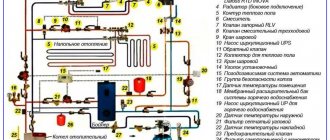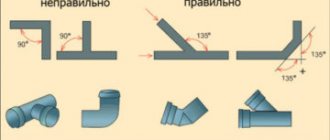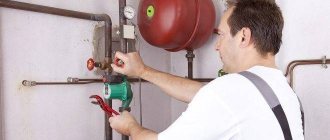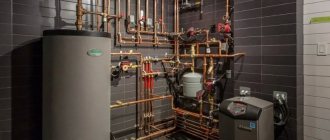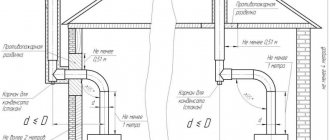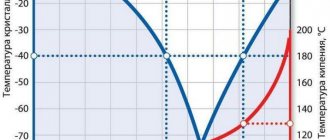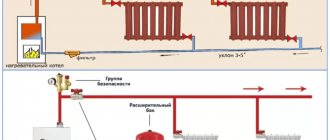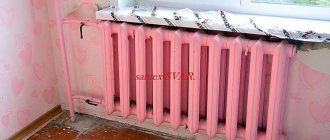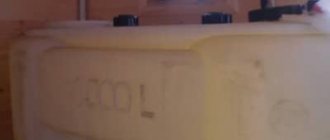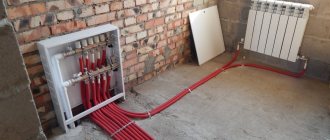When faced with repair work, going on a long trip or becoming a victim of an emergency, many people wonder whether it is necessary to drain the water from the heating system? In most cases, the answer is positive, although there are also situations where it is possible to fix a problem or make repairs with radiators filled with liquid.
Although the draining procedure is not particularly complicated, following the operating rules is an important nuance. If you violate the procedure, you can flood the floors in your own home with water. And if the drainage is carried out in a multi-story building, then neighbors may also suffer from incorrect actions.
Why do you need to drain water from heating systems?
Draining the heating system is necessary in the following cases:
- when it is necessary to eliminate leaks in pipes;
- if old radiators are replaced with more modern models;
- when preventive measures are taken to clean the system of accumulated contaminants;
- if you need to replace the coolant.
It is impossible to carry out this work with filled cavities of batteries and pipes. Water is drained in the event of an emergency or at a time when the owners of the homes intend to leave the premises for a long time.
Is it possible to do without draining the riser?
Minor repairs or simply replacing the battery do not require draining the entire heating system. In almost all apartments, you can shut off a separate radiator without affecting the general circuit.
1. Turn the corresponding tap on the heating riser and shut off the coolant supply.
2. Open the outlet valve on the radiator or unscrew the cap using an adjustable wrench. Drain the water into a container.
If there is neither a plug nor a tap, then disconnect the heating battery and drain the coolant. This will turn out to be more difficult and dirtier, but there is no other way.
Sometimes, for minor repairs, you do not need to drain the water, but simply shut off its supply to the internal circuit.
Design features of the heating system drain
The heating system of an apartment building and a private building has significant differences. Heating in cottages occurs through an autonomous system, which includes a boiler, pipelines, valves and radiators themselves, and sometimes an installed underfloor heating system.
In multi-storey buildings, the main structural elements are the supply and return risers, the internal piping system, shut-off valves, drain valves and the radiators themselves. In this regard, draining water from the heating system will be slightly different for both systems, although the operating principle is the same.
Boilers
Residential premises are heated by a boiler with one or two circuits. In the second case, the owners also provide themselves with hot water.
Many heating devices also have internal cavities where the coolant reaches a given temperature. And after draining the liquid from the unit, its interior becomes free of water, and convenient conditions are created for working with all components and contacts.
The nuances of emptying boilers in the house were reflected above. But there are some more subtleties:
How to drain water from a double-circuit gas boiler correctly? This means emptying the heat exchanger. To do this, turn off the boiler and open the hot water tap until it cools down. After this, the flow of cold water is blocked. If necessary, all its contents are removed from the heat exchanger. Then the hot water supply fitting is unscrewed.
How to drain water from a modern wall-mounted gas boiler? Such devices have a drain fitting and an air vent. These elements work automatically. And to free such a boiler from liquid, simply open the drain valve after the preparatory stages.
How to properly drain a heating system?
Having understood the main elements of the heating structure, you can begin to empty it. How to properly drain the heating system in private and apartment buildings?
Drain in a private house
For the draining procedure, the cottage owner will have to prepare a hose in advance, through which the liquid released from the system will flow. One end of the hose is connected to the boiler tap, the other is sent to the most convenient place for the home owner, where the structure can be emptied without damage (on the land of a personal plot, sewer).
Sequence of actions for draining water:
- The boiler turns off and its operation stops.
- A hose is attached to the boiler return valve (usually the outlet pipe is located on the right side under the boiler), so emptying occurs faster. If the crane is not located under the structure, refer to the free-standing system diagram and find out its location. The return part of the hose is directed into a sewer drain, front garden or a regular bucket.
- Open the valve and wait until the liquid stops flowing out (the pressure in the system decreases during this period), then close the valve back.
- After draining, care must be taken to ensure air access into the cavity of the structure. To do this, it is necessary to open the so-called Mayevsky valve, which is usually located at the highest point of the autonomous system. For example, on a heated towel rail or one of the radiators (if the cottage is two-story, then Mayevsky’s tap will be on the radiator of the 2nd floor).
- The air will begin to push out the remaining water from the batteries and the boiler, so draining must be done again.
- Now that there is practically no liquid left in the system, its insignificant remains are “blown out” by opening all the Mayevsky taps in the structure, and the water is drained again.
- Now the end of the hose, attached to the return pipe, is removed from it and attached to the supply valve.
- The final drainage of liquid from the heating system is carried out. To achieve maximum emptying, it is necessary to install the hose as low as possible in relation to the outlet taps.
However, if the owner of a private house has a heated floor system installed, then the above-described scheme will not help him. To remove liquid from it, you will need to use a special compressor.
Drain in an apartment building
Emptying the heating system in a multi-story building is more difficult in that it is necessary to obtain permission from the local management company to drain the riser. This service is paid, and the date will be set not by the owner of the apartment, but by housing and communal services employees, which may cause some inconvenience.
It is better to plan heating system repair work for the end of spring - summer - beginning of autumn, since during the heating period it is possible to drain the liquid only for a few hours and at a high cost.
However, it is possible to replace the battery or carry out minor repairs without emptying the entire heating structure. Most radiators are equipped with valves that can be used to block the flow of coolant to a local area.
- The tap is closed to shut off the water supply to the radiators.
- Using an adjustable wrench, remove the plug or, if present, open the outlet valve. The liquid is drained into a basin or bucket.
- If there are no outlet holes, you will have to disconnect the battery completely and get rid of the coolant through the top.
The essence of the
The first step is to shut off the branch of the heating riser that goes to the apartment. It is enough just to close the distribution valve located here. For a private house with an autonomous heating system, this process is slightly different:
- firstly, you need to stop the supply of fuel or electrical energy;
- secondly, you should carefully read the user instructions for this case.
Only after this can the boiler be turned off. Then you should close the valve through which water is drawn into the system.
To speed up the process a little, you will need to know those places in the system where taps with air-type valves may be located. They all need to be opened. In this case, nothing will interfere with the flow of water to the hose.
During this operation, small leaks of water from the system onto the floor are possible. Therefore, at the very beginning, it is better to place a large bowl or basin under the place where the hose is connected to the tap (drain). As all the water leaves the system, it is necessary to disconnect the hose and drain the remaining water from it into a substitute container.
Only after completing all the described procedures can you move on to the main thing - to the work for which the water was drained from the heating system of a residential apartment or private housing construction.
If the owner of an apartment or house does not quite understand how to drain the water from the heating without harmful consequences, then it is better to contact a qualified contractor. For example, to a plumber from a company that services a specific home.
When winter weather sets in, around the end of October, it is imperative to drain all the water from the water supply system of the dacha. If the water is not drained, the system will fail, the taps will burst, and the storage water heater will simply burst.
In all of our plumbing installations, we provide two valves for draining water from indoor pipes, a drain valve on the water heater, and drain valves in the well or borehole.
It will take us a little time to drain the water:
3. Open taps 1,2,3,4 (see diagram below) - if they were closed for any reason and all taps (mixers) on all floors of the cottage or house, wait until all the water from the water supply drains into home.
4. Open the drain screw in the well to drain water from the main line. If you have a drain valve installed, the water will drain automatically when the pressure drops to 0.2 atm.
5. Unscrew the bottom part of the filter (such a transparent flask) after placing a basin or other container of at least 5 liters - it contains water!!! Discard the used internal filter. Install a new one next year. Do not screw the removed flask onto the filter for the winter!
6. To be safe, you need to drain the water from the sink siphon.
7. Don’t forget to drain the water from the toilet tank and the toilet itself.
The main reasons for draining water from a heated floor system
There can be quite a few reasons why you need to drain the water from the heating system pipeline yourself - from the upcoming long absence of residents from the house to replacing the water in the system with antifreeze. In order to do everything correctly and not cause damage to the heating system, we will look in more detail at how to drain the water from a heated floor yourself.
A common reason for the need to drain the coolant is the preservation of the heating system for the winter when using ordinary water in the circuit. Before the onset of cold weather, this event is mainly carried out at dachas and country houses that are not used in winter. To simplify and speed up the draining process, special equipment is used.
Mobile air compressors (electric motor driven)
Important! In seasonal housing, failure to drain water from the heating circuit of underfloor heating before frost sets in can result in the system defrosting, so using antifreeze as a coolant is undoubtedly preferable - in addition to being resistant to low temperatures, these liquids are less subject to wear on pump parts.
Another equally important measure when operating underfloor heating is preventive maintenance on the heating system. Boiler water contains a lot of impurities, which, when heated, precipitate or form layers on the walls of the pipeline. Due to a decrease in the internal clearance of heat pipes, the circulation of the coolant in the system is disrupted and heat transfer is reduced. For this reason, when using water, the coolant must be drained once or twice a year.
A water circuit filled with antifreeze does not suffer from this problem. In this case, the coolant is replaced every 3-5 years - provided that the boiler is operated without overheating (for heated floors, the maximum permissible heating temperature threshold for the coolant is 45-55 0 C).
One type of antifreeze for filling the circuits of underfloor heating systems
Another reason for the need to drain the coolant may be the liquid losing its physical properties. A change in the characteristics of antifreeze occurs after overheating - the solution begins to foam, filling individual sections of the heat pipes with foam, which disrupts the circulation of the coolant in the system and reduces heat transfer.
Failure to comply with the technology for installing heated floors, or the use of materials not intended for contact with chemicals, causes the occurrence of corrosive processes in the heating system, as a result of which the circulation of the coolant is also disrupted and leaks in the water circuit occur.
Naturally, you will have to drain the water from the heated floor pipeline when replacing it with antifreeze - modernization.
These are the main reasons for the need to empty the underfloor heating system and, regardless of the base, the water must be drained in accordance with all the rules, following safety precautions and observing the technological sequence of the component operations.
In what cases is it not necessary to blow out pipes?
When preparing for the winter season, it is not always necessary to pump water out of the pipes. This work may not be carried out if:
- non-freezing liquid is used as a coolant;
- the pipeline is located below the freezing depth;
- In the region, the air temperature does not drop below -5°C.
Some owners protect pipeline systems from the cold using thermal insulation pipe insulation. But even with them, the water will freeze in winter. Insulation will help you safely use the water supply during the first frost, so it is used when installing the water supply system so as not to deprive yourself of water in the last days of your stay at the dacha.
If you pump out all the water from the pipeline in time, it will easily survive the winter. The materials from which the pipes are made are not afraid of low temperatures, so in the spring the owners will be able to start the water supply without fear of a breakthrough.
Video instructions for using an air compressor:
Procedure for draining water from the system
Warm floors are a closed system, so it is necessary to take care of the drain taps at the installation stage. The number of valves must correspond to the number of water circuits.
A heated floor is actually a long hose laid into the floor. Installation method - the configuration of the circuits may be different, but the principle of operation of the water circuit is the same - the coolant transfers heat to the surrounding space by heating the floor surface.
Image of the outline of a copper pipe underfloor heating system laid on reinforcing mesh in front of the screed device
Before starting the operation to drain the coolant, the heating system is turned off, after which the time necessary for all its elements to cool completely is waited.
Technical subtleties and nuances
In preparation for draining, it is necessary to study the structure of the collector in order to find and mark on the supply and return the location of the valves, marked as follows:
- servers are red;
- reverse flow - blue.
Connection diagram for a compressor for emptying the circuits of the underfloor heating system
If you confuse the supply with the return, the drainage system will not work - the check valve will block the pipeline.
If there is no receiving container, then you can connect the drain hose to the return valve and stretch it to the nearest sewerage intake - a toilet, sink or drain.
Collector unit for a warm water floor system
Having finished draining water from one circuit, empty all the others in the same way. When draining a section of the system, the valves of the remaining circuits must be closed, and at the end of each stage, the taps of the emptied pipelines must also be closed.
To completely empty the circuits, the purge procedure can be repeated after an hour - when the moisture from the walls of the heat pipes has drained and accumulated in some area.
Now the only water left in the water heater is to drain it too:
2. During installation, we always install a drain tap (6) and a safety valve (5). If the drain valve (6) does not have a flexible connection (optional), install it. With a flexible hose, it is more convenient to drain water into a container located on the floor. The volume of water drained is equal to the volume of your water heater!
3. Wait until the water is completely drained from the water heater drain tap. Now some water remains in the safety valve (5). To drain water from the valve, turn the lever on the valve up. Note: On some valve models, the tab is held in place by a small screw. The screw must be unscrewed, the water drained and put back in place.
Why is water drained from the heating system?
Water from the heating system must be drained in order to carry out repair work and improve the quality of coolant supply. Basic work that requires draining water from the heating system:
- Replacement of plumbing fixtures.
- Repair work, elimination of leaks.
- Preventive flushing and de-airing of the system.
- Replacing the coolant.
Draining water from the heating system may be necessary due to replacement of the coolant
It is mandatory to drain water from the system in a private home if the owners are absent for a long time. During this period, no one monitors the boiler, and the coolant does not heat up. The liquid in the pipes cools, freezes, expands and can rupture them. If the house has heated floors that are heated with water, then if they are damaged, repaired, or the owners leave, the water must be drained.
Coolant replacement reasons and frequency
Replacing water in a closed and open heating circuit is carried out:
During the first heating start.
After installation, the system is filled and started
After seasonal drainage.
When starting after repair work.
Regular topping up of liquid is required during operation if it has not been drained after the heating season.
Why drain your home system?
A question for which there is no clear answer is whether it is necessary to drain the circuit annually after the end of the heating season? The decision depends on the type, age and material of manufacture of the main elements - pipes and radiators, as well as on the total volume of liquid.
Each type has its own frequency of media replacement
Most often, systems with old cast iron radiators are drained for the summer. The reason is the appearance of a leak after the boilers are turned off. The old cast iron ribs are connected to each other by threaded connections with old gaskets. When there is hot water inside the batteries, the seals expand, providing a stable seal at the seams.
After the water cools, the material from which the gaskets are made naturally contracts and begins to flow at the junction of the ribs. But prolonged idle time of old radiators without water is fraught with accelerated corrosion; the rust inside the radiator and old pipes crumbles in a dry environment, and can damage the entire riser.
In closed new circuits, filling the heating system is not a costly process. But it is not recommended to completely drain the liquid every year - this is not necessary.
Frequency of replacing and topping up fluid in the heating system
How often do you need to change the fluid in your heating system? A few general rules:
In open-type circuits of private houses, it is enough to simply add water if the system is sealed, without subjecting the old communications to stress tests in the form of long dry periods. Replacement is necessary only in case of emergency repair or preventive sealing, after washing.
If a leak occurs, it is necessary to drain the water and carry out repairs.
Closed heating systems require preventive flushing and replacement of the coolant after several years.
The frequency of filling with new liquid depends on the characteristics of the water, the service life of the synthetic coolant, and the general condition of the system. If the extreme points are very airy, it is recommended to identify the cause - find the location of the leak and check the tightness of the heating network. Typically, water changes are carried out every few seasons.
System design features
The design of the heating system in an apartment building is of two types: two-pipe and single-pipe. The single-pipe system has the main disadvantage of cooling the water on its way to the upper floors. Heat is directed from the bottom up under pressure, bypasses all thermal circuits and flows back through the same pipe.
In a two-pipe heating system, the coolant returns back through the second pipe, and the temperature is maintained high as it enters the system throughout its entire route.
Heating systems are also divided into open and closed. In an open system, water comes directly from the heating plant and is distributed through heating and hot water pipes. Most apartment buildings are built according to this type.
Rules and stages for draining water from the heating system
How to properly drain water from the heating system in a house or apartment? It is necessary to take into account the design features of the heating system and follow the procedure.
Draining the heating system in a private house
The heating system of a private house is usually autonomous and draining does not require any permits or agreements with neighbors. It is recommended to drain the heating system in the following order:
- Disconnect the heating boiler from the network.
- The water in the pipes and radiators must cool completely.
- Turn off the cold water tap.
- Open the air valve.
- Open the valves on the radiator and boiler.
- Connect the hose to the drain valve, which is located on the return pipe near the boiler. The other end of the hose must be lowered into the toilet or a large container if the hose is short.
- Open the drain valve.
- Pump out the water until the pressure gauge shows zero.
- Open the Mayevsky tap and let air into the heating system. The air will push out any remaining water.
- Move the hose to the supply valve, open it and drain the liquid from the upper pipe.
A compressor is needed to drain water from the underfloor heating system. It is connected to the inlet pipe, turned on, and the air supply promotes the movement of liquid in the thermal circuit. A drain valve is installed on the return pipe, which opens to remove water. The compressor increases pressure gradually and stops draining when air is released at the outlet. Heated floor circuits have a small capacity and hold no more than 10 liters of water.
After draining the coolant is completed, the necessary actions to repair or reconstruct the system begin. Or they calmly leave the house for the winter, eliminating the risk of rupture of heating pipes.
Preparatory work
The first thing you need to do when starting this work is to turn off the boiler and turn off the taps at its inlet. However, this last operation is not necessary in some cases.
For example, if the boiler is located at the highest point of the heating system and you only plan to remove the primary heat exchanger or drain the water from the expander.
But if you plan to disassemble the hydraulic unit, remove any components from it, for example, a water flow sensor or a make-up valve, remove the secondary heat exchanger, etc. then turning off the tap at the inlet is a must!
But however, if in doubt, block it in any case, it won’t hurt.
Then you need to prepare a five-liter container, it’s a good idea to find a 1.5-meter piece of hose, and a rag may also come in handy.

